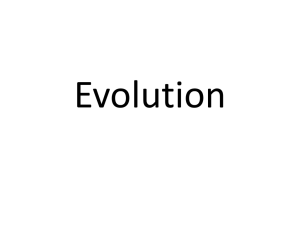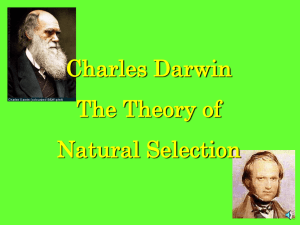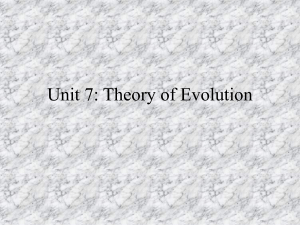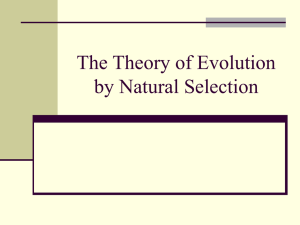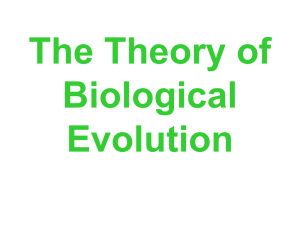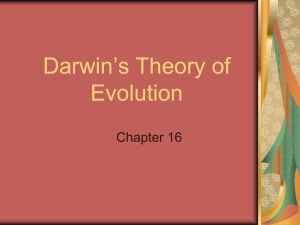PowerPoint Presentation - EVOLUTION
advertisement
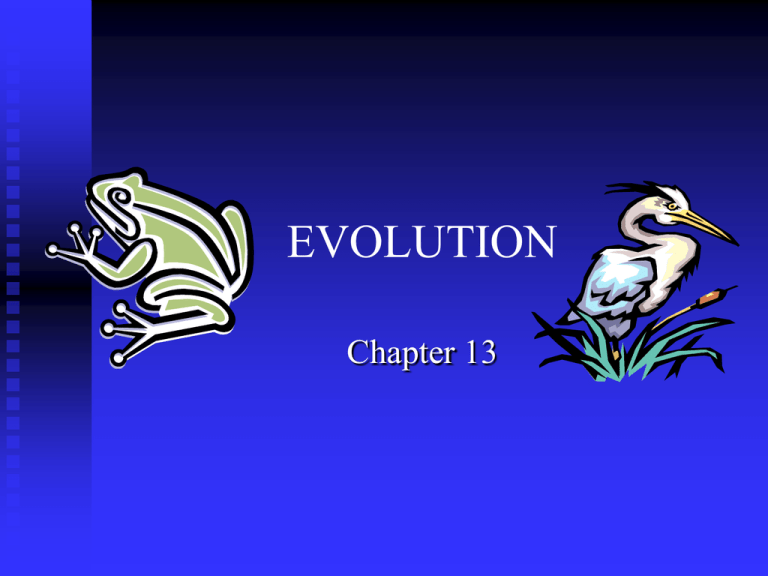
EVOLUTION Chapter 13 Section 1: Charles Darwin and his theories Darwin’s Theory of Evolution Evolution, or change over time, is the process by which modern organisms have descended from ancient organisms. A scientific theory is a well-supported testable explanation of phenomena that have occurred in the natural world. Voyage of the Beagle Voyage of Beagle Dates: February 12th, 1831 Ship: H.M.S. Beagle Destination: Voyage around the world. Findings: evidence to propose a revolutionary hypothesis about how life changes over time as a result of an organisms environmental conditions. Science Before Darwin’s Voyage Most people believed each species was a divine creation. Scientists were trying to explain the origin of fossils. Some tried to explain it by altering traditional explanations. Others (including Darwin’s grandfather) proposed mechanisms to explain how living things change over time. 1809: French scientist Jean Baptiste Lamarck proposed a hypothesis for how organisms change over generations. He believed that over the lifetime of an individual, physical features increased in size b/c of use or reduce in size b/c of disuse. He also believed these changes were then passed on to offspring. Science Before Darwin’s Voyage This is now known to be incorrect, however he did correctly point out that the changes that occur in species are due to the physical conditions of life- this refers to an organisms environmental conditions. Darwin’s Observations During Darwin’s voyage on the Beagle, he found evidence that species were not unchanging. Darwin was reading a book that discussed how changes in the Earth could occur over many years. While he was out, he started to notice evidence of this. Fossils- he found fossils in South America of extinct armadillos. These armadillos closely resembled, but were not identical to the armadillos still living in the area. Fossils The Galapagos Islands Located 620 miles off the coast of Ecuador. He noticed that many plants/animals resembled those of the nearby coast of South America. Darwin hypothesized that the most simple reason for this was that these animals had migrated to the islands and then changed over time. Eventually Darwin called this “descent with modification” – what we now refer to as evolution. Animals found in the Galapagos Land Tortoises Darwin Finches Blue-Footed Booby Marine Iguanas Animals The Journey Home When Darwin was 27, he returned home, but did not report his findings. He continued to study his data, until his confidence grew that he was correct in his conclusions. His hypothesis: Separate species may have arose from an original ancestor Population Growth Thomas Malthus-19th century English economist If population grew (more babies born than die) Insufficient living space Food runs out (populations are able to increase faster than food supply increases). He proposed that human populations do not grow unchecked because of death caused by disease, war, and famine that slows population growth. Darwin applied this theory to animals. Growth of Populations Population: includes all of the individuals of a species that live in a specific geographical area AND can interbreed (breed with one another). Evolution by Natural Selection Darwin realized that Mathus’ conclusions about human population growth applied to all species. Every organism has the potential to produce many offspring during its life time. But, not all of them will survive. Natural Selection After gathering all of his information, Darwin made a conclusion: “individuals that have physical or behavioral traits that better suit their environment are more likely to survive and will reproduce more successfully than those that do not have such traits”. Darwin called this natural selection. Over time, the number of individuals that carry favorable characteristics that are ALSO inherited will increase in a population. Therefore, the population will change. This changes = evolution. Publication of Origin of Species 1844 Darwin wrote down his ideas about evolution & natural selection, but didn’t publish his data due to the controversy that other scientist were facing concerning this topic- he wasn’t confident enough. Finally, he wrote the book & it was published in Nov 1859. Darwin’s theory of evolution by natural selection is supported by 4 major points. 1) Inherited variation exist w/in the genes of every population or species (the result of random mutation & translation errors). 2) In a particular environment, some individuals of a population or species are better suited to survive (as a result of variation) and have more offspring (natural selection). 3) Over time, the traits that make certain individuals of a population able to survive and reproduce tend to spread in that population. 4) There is overwhelming evidence from fossils & many other sources that living species evolved from organisms that are extinct. Darwin’s Ideas Updated Change within populations: Darwin’s main point was that in any population, the individuals that are best suited to survive & do well in their environment will produce the most offspring. So, the traits of those individuals will become more common in each new generation. Now, we know that genes are responsible for inherited traits. Natural selection causes the frequency of certain alleles in a population to increase or decrease over time. Mutations & the recombination of alleles that occurs during sexual reproduction provide for endless sources of new variation. Species Formation Because the environment differs from place to place, populations of the same species living in different locations tend to evolve in different directions. Reproductive Isolation is the condition in which two populations of the same species do not breed with one another b/c of geographic separation, a difference in mating periods, or other barriers to reproduction. Reproduction Isolation As two isolated populations of the same species become more different over time, they may eventually become unable to breed with one another. Usually, when this happens, the two populations are subsequently considered to have become two different species. The Tempo of Evolution Evolution is understood to be a gradual process that occurs continuously. This is called gradualism. Some scientists believe that evolution of some species may actually occur in short spurts, followed by long periods of no change. This change is called punctuated equilibrium. Natural Selection Over time, natural selection results in changes in inherited characteristics of a population. These changes increase a species fitness in its environment Evidence of Evolution The Fossil Record Geographic Distribution of Living Things Homologous Body Structures Similarities in Early Development Evidence of Evolution The Fossil Record Geographic Distribution of Living Things-similar environments have similar types of organisms Homologous Body Structures Similarities in Early Development Section 2: Evidence of Evolution Fossils: offer the most direct evidence that evolution takes place. A preserved/mineralized remain or imprint of an organism that lived long ago. Provide an actual record of Earth’s past life-forms. Change over time can be seen in the fossil record. • ie. Fossilized species found in older rocks are different from those found in newer rocks. After observing the differences in fossils, Darwin predicted that intermediate forms between groups of organisms would eventually be found. Some have been found. Some have not. These intermediate forms are called transitional fossils. Any fossil which gives us information about a transition from one species to another. Examples of transitional fossils Darwin’s theory is almost universally accepted by scientists as the best available explanation for the biological diversity on Earth: Based on supporting evidence, most scientists agree on these 3 points: The Earth is about 4.5 million years old. Organisms have inhabited the Earth for most of its history. All organisms living today share common ancestry with earlier, simpler life forms. Problems with fossils Many species have lived in environments where fossils do not form. The environments most likely to cause fossil formation are wet lowlands, slow-moving streams, lakes, shallow seas, and areas near volcanoes that spew out volcanic ash. The chances that organisms living in certain areas will die at just the right spot to be fossilized are low. Even if this does happen, the chances are low that the dead body will be buried in sediment before it decays and/or is eaten by scavengers. Rate of decay varies among organisms (hard skeleton vs soft skeleton). Studying fossils Paleontologist: scientists who study fossils. They analyze the sediments around the fossils. They use radiometric dating of certain rocks and minerals to arrange fossils in order from oldest to youngest. This creates a visual pattern of evolution. Anatomy & Development Studying the anatomy of different types of organisms often reveals basic similarities in body structures even through the structures function may differ between organisms. Vestigial structures Homologous structures Embryonic development Homologous Structures-structures that have different mature forms in different organisms, but develop from the same embryonic tissue. Vestigial organs-organs that serve no useful function in an organism i.e.appendix, miniature legs, arms Similarities in Early Development Biological Molecules In order for biology to match up with the changes in fossils, then changes in a gene’s nucleotide sequence should build up over time also. Proteins One idea is that if evolution has taken place and a species has descended from a recent common ancestor, then they should have few amino acid differences in their proteins. This has been supported in test with hemolglobinthe same hemoglobin protein in several species was analyzed and found to have few amino acid differences. DNA Sequences This pattern is not true for all proteins. Some change faster than others, so the relationship may not be seen, if it did exist. Section 3- Examples of Evolution Natural Selection at Work In Darwin’s writings, he offered examples of how natural selection could have shaped life on Earth. KEY POINT: The environment dictates the direction and amount of change. If the environment changes in the future, the set of characteristics that most help an individual reproduce successfully may also change. Factors in Natural Selection The process is driven by 4 important points that are true for all real populations. All populations have genetic variation The environment presents challenges to successful reproduction. Individuals tend to produce more offspring than the environment can support. Individuals that are better able to cope with the challenges tend to leave more offspring than those who aren’t. An example Evolution of antibiotic resistant diseases. The bacteria needs to survive to reproduce. Eventually, a mutation will occur in its genome that will allow even one bacteria cell to fight off the antibiotics. As it reproduces, more antibiotic resistant cells are made and the antibiotic currently used becomes ineffective. Darwin’s Finches: different beaks utilized during food shortage. Formation of a new species Species formation occurs in stages. Natural selection favors changes that increase reproductive success. So, species are improved to “fit” into their environment (ie. Fitness). Accumulation of differences between groups- divergence. Divergence leads to the formation of new species. Formation of new species- speciation. Forming subspecies In environments differ enough, then separate populations of the same species can become so different that they become a new species. Populations of the same species that differ genetically b/c of adaptations to different living conditions become subspecies. Once they are different enough, the subspecies may become a completely separate species. Due to reproductive barriers that form. Summary of Darwin’s Theory Individuals in nature differ from one another Organisms in nature produce more offspring than can survive, and many of those who do not survive do not reproduce. Summary of Darwin’s Theory Because more organisms are produce than can survive, each species must struggle for resources Each organism is unique, each has advantages and disadvantages in the struggle for existence Summary (cont.) Individuals best suited for the environment survive and reproduce most successful Species change over time Summary (cont.) Species alive today descended with modification from species that lived in the past All organisms on earth are united into a single family tree of life by common descent
